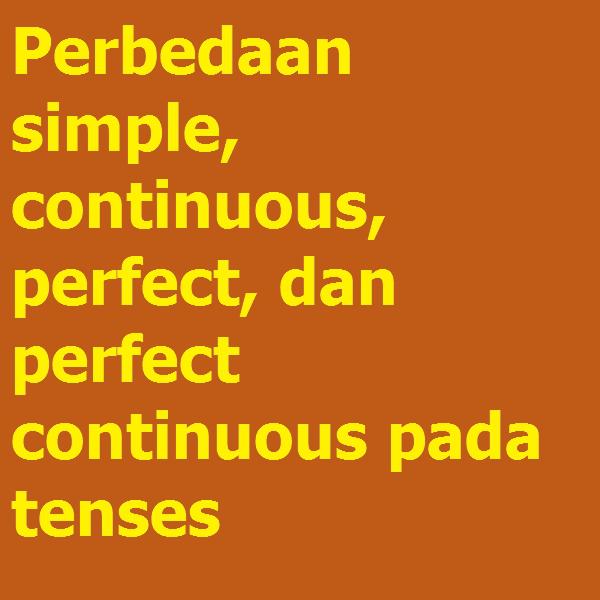
Apa perbedaan simple, continuous, perfect, dan perfect continuous pada tenses serta bagaimana contoh kalimatnya?
Ada empat bentuk dasar tenses yaitu simple, continuous, perfect, perfect continuous. Penjelasan empat bentuk dasar itu adalah sebagai berikut:
a. Simple, artinya sederhana atau semata-mata mengikuti empat bentuk umum tadi. Ada empat jenis simple:
- Present simple, pola: S + V1, cth: Andi works everyday.
- Past simple, pola: S+V2, cth: Andi worked in Bali yesterday.
- Future simple, pola: S+will +V1; S +shall+V1, cth: Andi will work in Bali next month.
- Past Future Simple, pola: S+ would+V1; S+ should+V1, cth: Last year, Andi said that he would work in Bali last month.
Kita bisa menggabungkan present simple dan present future menggunakan time clause (as soon as, when, after, before,dll) dengan aturan setelah time clause harus diikuti present simple.
Contoh: I will telephone
[simple future] as soon as I arrive
[simple present]
b. Continuous, artinya sedang berlangsung. Pola dasarnya adalah S + to be + V ing. Ada empat jenis Continuous, semuanya berpola S + to be + V ing, tetapi to be nya mengikuti bentuk umum. Empat jenis tersebut yaitu :
- Present continuous, menggunakan to be bentuk present (is, am, are)
contoh : Andi is working now. - Past continuous, menggunakan to be bentuk past (was, were)
contoh: Andi was working at 02.00 p.m. yesterday. - Future continuous, menggunakan will + to be bentuk future (be)
contoh : Andi will be working at 02.00 p.m. tomorrow. - Past future continuous, menggunakan would + to be bentuk past future (be)
contoh : Andi would be working at 02.00 p.m. yesterday.
sekarang anda sudah memahami delapan bentuk tenses.
c. Perfect, artinya telah terjadi, selesai, atau sempurna dan masih ada hubungannya dengan salah satu waktu pada bentuk umum. Pola dasarnya adalah S + Have/Has + V3. Ada empat jenis perfect, semuanya dibentuk dengan cara mengubah have/has pada S + Have/Has + V3 agar sesuai dengan bentuk umum. Empat jenis perfect tersebut adalah:
- Present perfect menggunakan Have/Has bentuk present sehingga polanya adalah S + Have/Has + V3 . contoh : Andi has worked for three years.
- Past perfect mengubah Have/Has ke bentuk past sehingga polanya adalah S + Had + V3. contoh: Andi had worked before i met him in 2009.
- Future perfect mengubah Have/Has ke bentuk future sehingga polanya adalah S + will + Have + V3. contoh: next year, Andi will have worked for four years.
- Past future perfect mengubah Have/Has ke bentuk past future sehingga polanya adalah S + would + Have+ V3, have disini tidak diganti had karena di depannya ada would.
contoh : Andi would have worked by the end of last month.
d. Perfect continuous, artinya telah terjadi sejak tadi, dan masih terjadi (disalah satu dari keempat bentuk umum). Pola dasarnya adalah S + Have/Has + Been + Ving. Setelah have/has harus bentuk ke-3, karena itu to be yang dipakai pada pola tersebut adalah to be bentuk ketiga yaitu been. Ada empat jenis perfect continuous, semuanya dibentuk dengan cara mengubah Have/Has ke masing-masing bentuk umum. Empat jenis tersebut yaitu:
- Present perfect continuous
pola : S + Have/Has + Been+ Ving
contoh : Andi has been working since 2007. - Past perfect continuous
pola : S + Had + Been+ Ving
contoh : Andi had been working for three years before i met him. - Future perfect continuous pola : S + Will + Have + Been+ Ving
contoh : I will have been washing, three hours again (direncanakan 3 jam lagi baru saja selesai) - Past future perfect continuous pola : S + would + Have + Been + Ving
contoh : He would have been finishing by last week ( dia akan sudah menyelesaikannya minggu lalu )